Wallasey Council/Corporation Tramways
History
In 1896, Wallasey Urban District Council decided to build a modern, municipally operated electric tramway system, and to trigger its right to compulsorily purchase the local horse tramway, which since the 8th May 1891 had been operated by the Wallasey United Tramway and Omnibus Company.
The council obtained powers (on the 6th June 1899) to reconstruct the horse tramway for overhead electric traction, build new lines, and operate the planned 8.5-mile system municipally; these were granted under the Wallasey Tramways and Improvements Act (1899). However, rather than sell out to the council, the WUT&OCo chose to fight on, as it believed that the council had forfeited its right to buy the company under the original 1878 enabling act (after 15 years had elapsed), and was thus not legally entitled to force through a compulsory purchase. After a long, drawn-out and acrimonious legal battle, which ended up in the House of Lords, the decision went against the company.
The council took over the tramway on the 1st April 1901, immediately investing in new horses and second-hand vehicles, and operating it very successfully pending conversion to electric traction. The first rails of the new overhead electric system were laid on the 24th June 1901 along Seabank Road, which did not have a horse tramway; however, by September 1901, construction elsewhere had started to impact the horse tramway, services being temporarily diverted, then reinstated as the new rails were laid. The first electric services commenced on the 17th March 1902, with the last council-operated horse tram running two days later on the 19th March 1902.
Unfortunately, the council had, like neighbouring Birkenhead, seriously underestimated the popularity of the new services, but was hamstrung in having built a significant portion of the system on the single line and loop principle, which greatly hindered its ability to run a more intensive service, even if it had had more vehicles than the 25 it had purchased. A rapid reappraisal of the situation led to a rethink, capacity being increased as soon as practicable by doubling another 3.38 route miles (during 1903/4), and purchasing an additional ten tramcars (five in 1903 and 5 in 1906).
The tramway was very profitable, frequently making significant contributions to the rates, as well as to sinking and renewal funds. The only financial issues were self-induced, the corporation, which like Liverpool was a big proponent of one-penny fare stages — and thus cheap travel — occasionally lengthening these stages (against the advice of the manager), only to have to reverse the decision following a significant and entirely predictable drop in takings.
With the success of the tramway, the council's thoughts soon turned to extending the system, and in particular, building a line out via Poulton to Wallasey Village. Unfortunately, there was significant opposition, particularly to the use of Breck Road, an attempt to secure powers for this failing in 1904, and again in 1906, the latter under the Wallasey Tramways and Improvements Act, 1906. Following repeated requests for a new line, the council eventually tried again, powers to build a 3.25-mile line being granted on the 16th August 1909 under the Wallasey Tramways and Improvements Act, 1909.
The new line was opened as far as St Lukes Church in Poulton on the 8th July 1910, and through Wallasey Village to connect to the Warren Drive line on the the 7th April 1911. Apart from some minor changes, this took the standard-gauge, overhead electric tramway to its final size of 12.02 miles. The system essentially comprised three lines to New Brighton, with a loop line via Poulton and Wallasey Village. From Seacombe Ferry, the Seabank Road line headed northwards via Demense Road to Brighton Street (inbound services being routed along Church Road), continuing northwards along King Street, Seabank Road and Rowson Street to Victoria Road in New Brighton, where there was a loop line to the Pier around Rowson Street, Virginia Road and back into Victoria Road. The Rake Lane routed headed westwards along Church Road and St Pauls Road, before turning northwards along Wheatland Lane, then northwestwards to Liscard via Liscard Road; from here the line continued to New Brighton northeastwards along Rake Lane to Rowson Street, where it joined the Seabank Road line. The Warren Drive line branched off the Rake Lane line at Liscard, heading northwards via Seaview Road, Hose Side Road and Grove Road, curving around Warren Drive and into Victoria Road, where it met the Seabank and Rake Lane lines. The Poulton line branched off the Rake Lane and Warren Drive lines in Wheatland Road, heading westwards along Poulton Road to Poulton, then winding its way northwards via Marlowe Road, Claremont Road and St Georges Road to Wallasey Village, whereupon the line turned eastwards along Grove Road to rejoin the Warren Drive line.
On the 19th July 1910, Wallasey was elevated to the status of a borough (and three years later, on the 1st April 1914, to a county borough), this being reflected in a change in the name of the undertaking to Wallasey Corporation Tramways.
The tramway was well maintained, the tramcar fleet reaching 62 cars by 1913, something which stood it in good stead during the Great War, when maintenance suffered and new equipment was virtually unobtainable. Doubling of the heavily used Seabank Road route was completed over the winter of 1914/15, with six new tramcars arriving in May of the latter year, improvements which were no doubt set in train before the outbreak of war. Whilst the system was very heavily loaded, it seems to have emerged from the Great War in much better shape than other systems, many of which were on their knees. The most pressing post-war issue was to raise prices, as the high inflation of the war and the period immediately afterwards, meant that takings were barely covering the operating costs. The track was also deteriorating following four years of minimal maintenance, its condition becoming a continual source of friction between the Tramways Department and the Borough Engineer, who was responsible for its upkeep.
The corporation quickly set about investing in its system, with various track replacements being undertaken, and more new cars arriving in 1920. Powers were also obtained to run motorbuses within the borough — on the 19th August 1920 —under the Wallasey Corporation Act (1920), the tramways being protected through higher bus fares. The first corporation motorbus service ran on the 3rd April 1920, presumably under a provisional arrangement pending the granting of powers. The first buses were, however, primitive solid-tyred affairs, and were not particularly popular; despite losses being incurred on these services, the corporation stuck with the buses, gradually introducing more modern vehicles, and expanding routes beyond the borough boundary, including running joint services with Birkenhead Corporation.
By the mid 1920s the track, which was still under the control of the Borough Engineer, was in need of major investment. This, as well as plans for new tramway extensions, provoked considerable debate within the council over the future of the tramways, the proposed extensions being rejected in favour of motorbuses. The cost of track replacement, and the increasingly successful bus services, inevitably led to a change of policy, with the buses carrying the day. This was despite powerful factions within the council advocating trolleybuses, so much so that powers were even obtained to operate them, initially as an adjunct to the tramway system — on the 22nd December 1927 under the Wallasey Corporation Act (1927) — but on the 8th July 1931, under the Wallasey Corporation (Trolley Vehicles) Order Confirmation Act (1931), to replace them. Both sets of powers were never used.
Meanwhile, the tramway track had been allowed to deteriorate further, particularly on the heavily used Seabank Road route, which thus became the first to be abandoned — on the 19th January 1929 — even though it carried a quite staggering 6,500,000 passengers during 1928, a number that the buses, with their lower capacity, would struggle to match. Needless to say, with the best route gone, it was only a matter of time before the others followed suit. Wallasey's last tram running on the 30th November 1933, returning to the depot at 40 minutes past midnight.
Uniforms
Although no photographs are known to have survived that unequivocally show the horse tramway during its council days, documentary evidence confirms that horse-tram crews were not provided with uniforms. Conductors and inspectors were, however, issued with caps and cap badges, very probably of the same type as provided to crews working the first electric services.
Early photographs show that staff working the electric services were provided with smart double-breasted, lancer-style tunics with stand-up collars and five pairs of buttons (narrowing from top to bottom) carrying the full system title, 'WALLASEY COUNCIL TRAMWAYS' around a monogram of the system initials, 'WCT' (see link). The stand-up collars carried individual system initials — 'W C T' — on the bearer's right-hand side, and an employee number on the left-hand side. The caps were of the drooping-peak type with steeply inclined glossy peaks; they bore script-lettering grade badges, either 'Motorman' or 'Conductor'. The early insignia were probably brass.
Several examples of nickel cap badges have survived; these take the form of an eight-pointed star with a monogram of the system initials — 'WCT' — and the grade, either 'DRIVER' or 'CONDUCTOR' in a scroll below. This style of cap badge probably replaced the script-lettering variety relatively early on, but was itself superseded around 1910, when the council was granted borough status (later county borough). The replacement badges bore the new corporation arms, above scrolls containing the corporation motto ('AUDEMUS DUM CAVEMUS') and the full system title: 'WALLASEY CORPORATION TRAMWAYS' (see below). Although these badges exist in nickel and chrome, all surviving corporation-era buttons are nickel (see link). The chrome cap badge is, however, almost certainly a later chromium-plating by an employee or the department workshop, as the lugs are also chromed; furthermore, this material did not gain widespread use for badges until after the demise of the Wallasey system (see link).
The use of the old fashioned drooping-peak caps appears to have persisted through to 1926 (certainly photographs exist from 1923 that clearly show staff wearing these) when they were replaced by tensioned-crown peaked caps; the cap badge remained unchanged. The switch to the more modern style of cap appears to have been the only change made to the style of the uniform over the entire lifespan of the tramway (1902 to 1933).
Tramcar staff were also issued with long, double-breasted greatcoats with five pairs of buttons and high, fold-over collars; the latter very probably bore the same insignia as the tunics worn underneath.
Photographs of inspectors are also rare, but enough have survived to give a good indication of the style of uniform worn, at least up until 1910. Jackets were single-breasted with hidden buttons (or more likely a hook and eye arrangement) and stand-up collars; the latter probably carried the designation 'Inspector' in embroidered script lettering, though the use of system initials cannot be excluded, as surviving photographs do not allow the precise form to be discerned. The jacket and pockets were both edged in a finer material than the main body. Headgear comprised the same style of drooping-peak cap worn by tramcar crews, but carrying a script-lettering grade badge — 'Inspector' — though whether this was embroidered or metal is currently unclear. System initials — 'W C T' — were carried above the grade badge, in individual letters, possibly brass. Following the change to the new star-shaped badges (in the mid-Edwardian era), inspectors also wore this new pattern of cap badge, but with the grade 'INSPECTOR' within the ribbon. A switch was almost certainly made to the new corporation cap badge in 1910, and to tensioned-crown peaked caps in 1926, however, photographic evidence that would either prove or disprove this has so far proved elusive. The new badge was identical to those issued to tramcar crews, but is believed to have been gilded brass rather than nickel; examples have survived in both a voided form (i.e., open-backed) and an unvoided form.
As with many tramway systems, women were employed in significant numbers during the Great War to make good the loss of male staff to the armed forces, though in the case of Wallasey, only as conductresses. The ladies were provided with long, tailored single-breasted jackets with high fold-over collars, a waist belt with two button closures, and a long matching skirt; the bearer's left-hand jacket collar bore an employee number (in individual metal numerals), the right-hand side system initials ('W C T') both probably in nickel to match the buttons. Straw bonnets were certainly worn in summer; these bore a ribbon, possibly with a cockade, but no cap badge. Winter wear was probably a felt bonnet, worn pinned up at one side in the manner of an Australian slouch hat; it is unclear whether the felt bonnets bore a badge.
Records from 1917 indicate that that there were 63 motormen (all male), 81 conductors (76 female), 3 ticket inspectors, 4 timekeepers, 1 depot inspector and 1 assistant depot inspector.
Further reading
For a history of Wallasey's tramways, see: 'The Tramways of Birkenhead and Wallasey' by T B Maund and M Jenkins; LRTA (1987).
Images
Motormen and conductors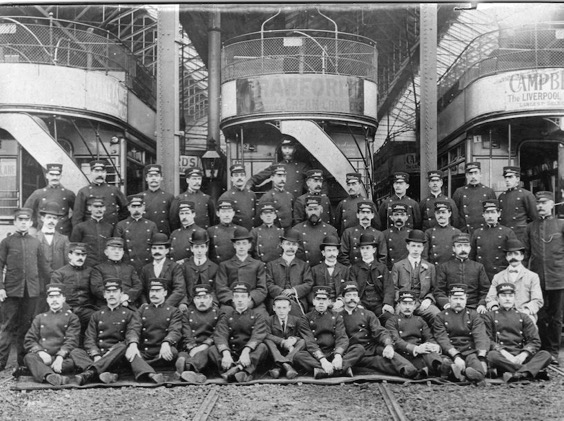
A staff photograph taken at Seaview Road depot in 1902. Photo courtesy of Rob Jones.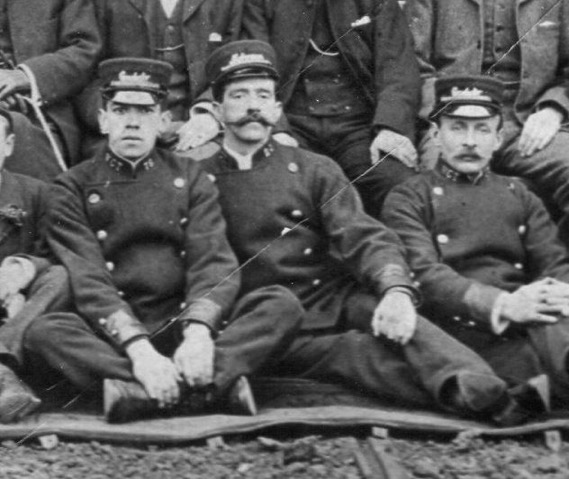
An enlargement of the above photograph showing two conductors and a motorman (the latter in the middle). They are all wearing drooping-peak caps bearing script-lettering grade badges; the collars of their lancer-style tunics bear system initials — 'W C T' — on one side and an employee number on the other.
Script-lettering grade badges of the pattern used by Wallasey Council Tramways on crew caps during the first few years of operation — brass. Author's Collection.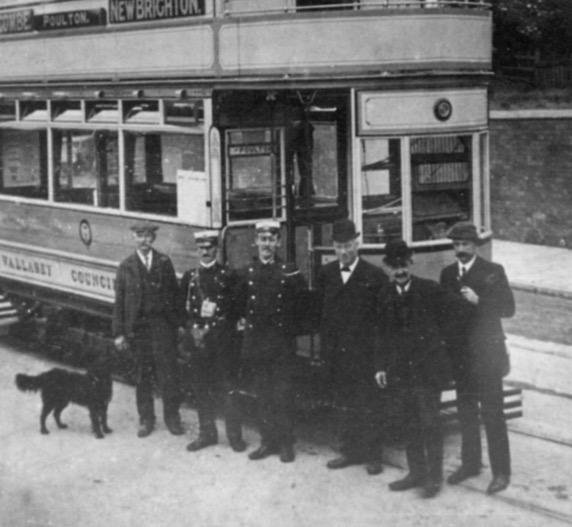
A conductor and a motorman pose for the camera with Tramcar No 48 on Rowan Street at the end of Field Road on the 8th July 1910, the opening day of the Poulton route. This was the year that Wallasey became a borough, the word 'COUNCIL' on the tramcar rocker panel gradually being replaced with the word 'CORPORATION'. The tram still carries the word 'COUNCIL', and the tramcar staff appear to have round cap badges, almost certainly the 8-pointed council star below. Photo courtesy of the Tramways and Light Railway Society, with thanks to David Voice.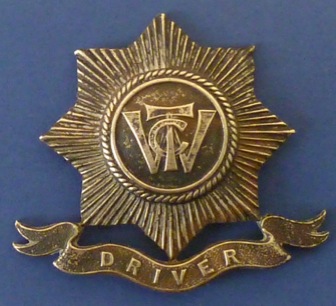
Wallasey Council Tramways 'DRIVER' cap badge, of the type worn from the mid-Edwardian era to around 1910 — nickel. Author's Collection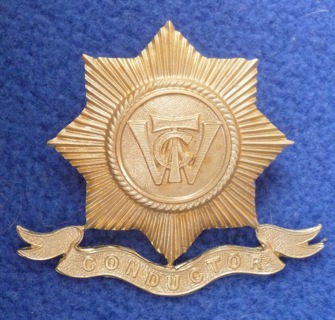
Wallasey Council Tramways 'CONDUCTOR' cap badge, of the type worn from the mid-Edwardian era to around 1910 — nickel. Author's Collection.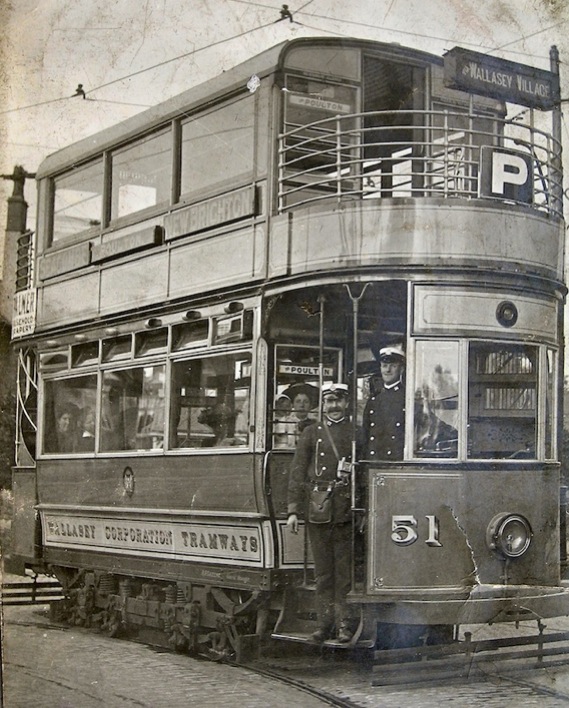
A conductor and a motorman pose on the platform of Tramcar No 51, pictured on the turning circle at the junction of Warren Drive and Grove Road — photo undated, but probably taken around 1913 when route letters were first introduced. Photo courtesy of Barry Ijewsky.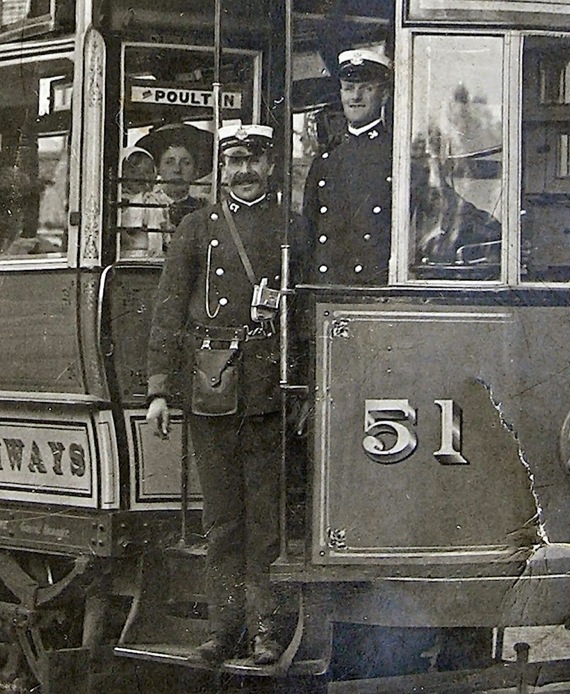
An enlargement of the above photograph showing the conductor and the motorman. The conductor is William Henry Davis, who was born in County Fermanagh in 1879, later tried his luck in America (in 1904), returned to Ireland and eventually moved to Wallasey. He started on the trams around 1908 as a conductor, moving onto driving, and later transferring to the council's refuse department, finally ending his days in New Brighton in 1951. Thanks to his grandson, Barry Ijewsky, for this information. Note the continued use of drooping-peak caps, which by this time (circa 1913), would have been distinctly old fashioned. The later 'corporation' cap badge, and the collar insignia are clearly seen.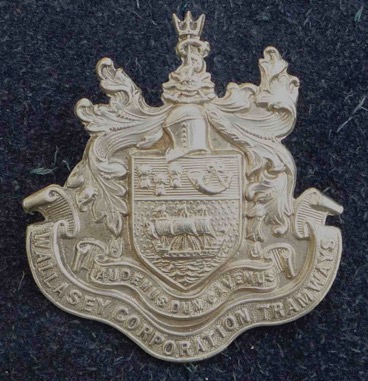
Wallasey Corporation Tramways cap badge, of the type worn from around 1910 to closure — nickel. Author's Collection.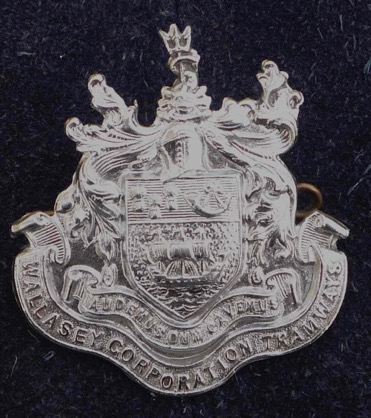
Wallasey Corporation Tramways cap badge, — chrome (probably a nickel example that has been chromium-plated as the lugs are also plated). Author's Collection.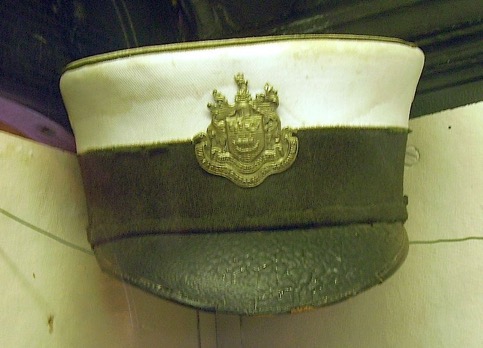
Wallasey Corporation Tramways drooping-peak cap with later-period cap badge. This combination would have been worn between around 1910 and 1926. Photo courtesy of Rob Jones.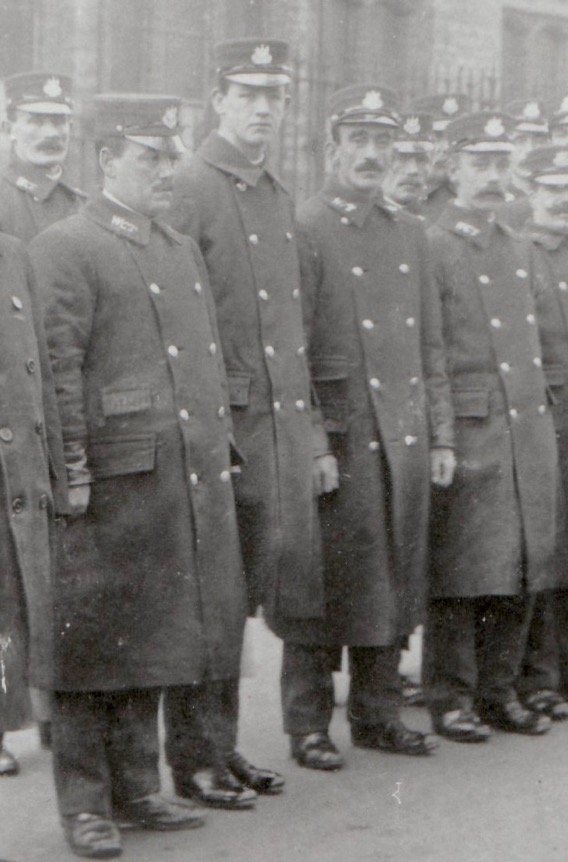
A line up of Wallasey Corporation Tramways tramcar staff — photo undated, but probably taken between 1910 and the start of the Great War. All are wearing double-breasted greatcoats and drooping-peak caps, but with the latter clearly bearing the new style of corporation cap badge. Photo courtesy of Rob Jones.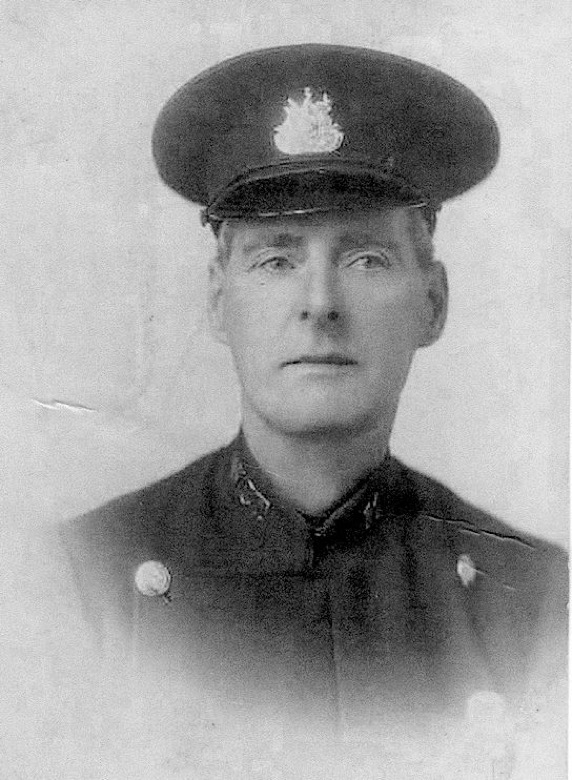
Motorman Edwin Thomas Davies, who worked on the tramway from 1902 until 1933, pictured in a tensioned-crown peaked cap, so taken some time after 1926. Photo courtesy of Rob Jones.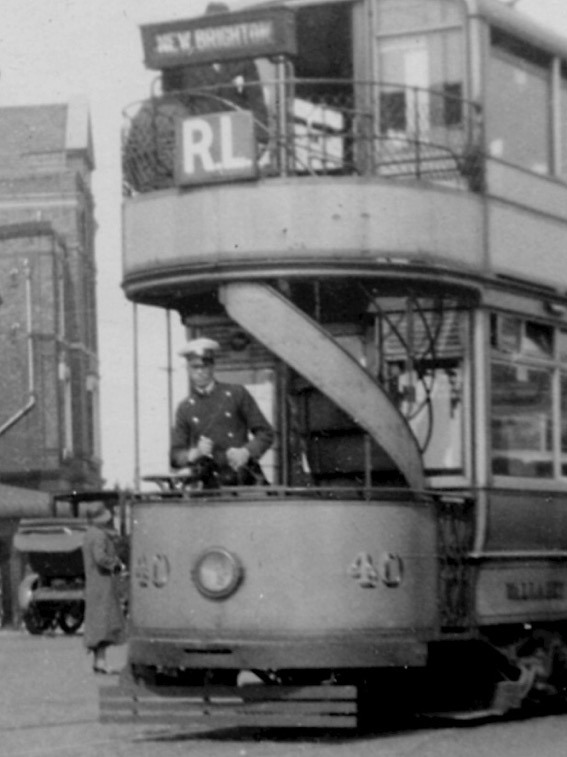
A motorman at the controls of Tramcar No 40 in Seacombe in the summer of 1932. Note the new tensioned-crown cap, but with the tunic unchanged, stylistically, from the opening day. Photo courtesy of the Tramways and Light Railway Society, with thanks to David Voice.
Senior staff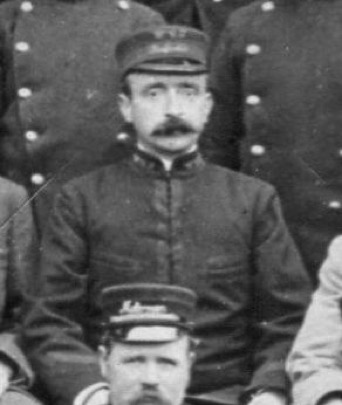
An enlargement of the 1902 depot photograph above showing an inspector. He appears to have a script-lettering grade badge — 'Inspector' — on his cap, above which are system initials (probably). The grade badge was probably embroidered (on a hat band), whilst the system initials may have been metal.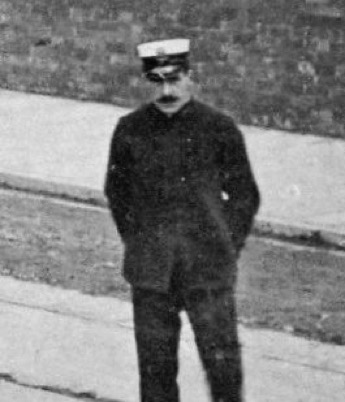
A WCT inspector pictured in 1910 (from the photograph of No 48 above, taken on the opening day of the Poulton route). The drooping-peak cap almost certainly bears the same pattern of star-shaped badge shown below. Photo courtesy of Rob Jones.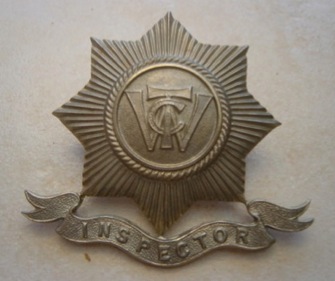
Wallasey Council Tramways 'INSPECTOR' cap badge, of the type worn from the mid-Edwardian era to around 1910 — nickel. With thanks to Dave and Helen Lewis.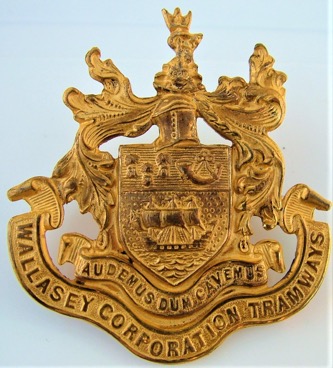
Wallasey Corporation Tramways cap badge worn from circa 1910 onwards — gilt. It is believed that senior staff wore badges in this material. Unlike the badges worn by tramcar staff, the badge is voided (i.e., open-backed). Courtesy of the David Wilkinson Collection.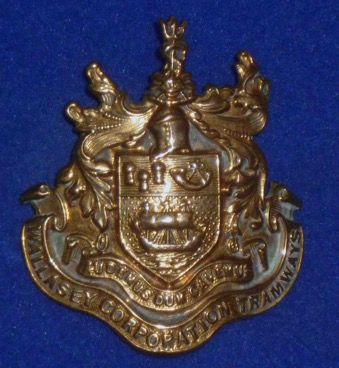
Wallasey Corporation Tramways cap badge, of the type probably worn by inspectors from around 1910 through to closure — brass or possibly worn gilt. Unlike the example above, this badge is not voided. Author's Collection.
Female staff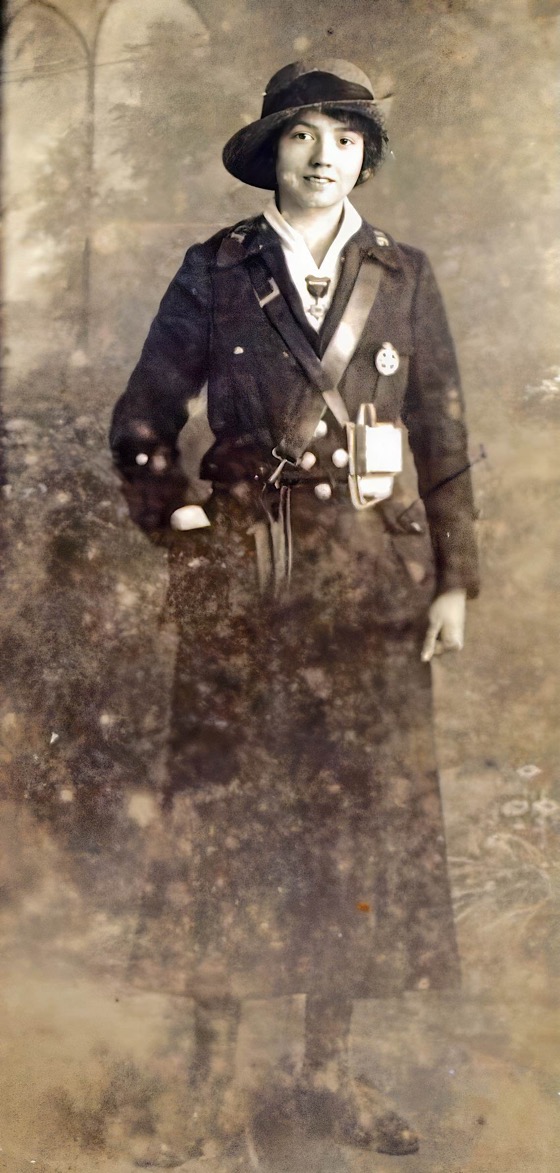
A rare photograph of a Wallasey Corporation Tramways Great War conductress, by the name of Mary Ann Vincent. She was born in Houghton-le-Spring in 1897, but at some point moved to the Wirral, where this photograph was taken in New Brighton. She later moved to Blackpool, marrying widower Jonathan Dixon there in 1921, and ultimately dying there in 1946. Photo courtesy of her grandson, David Dixon.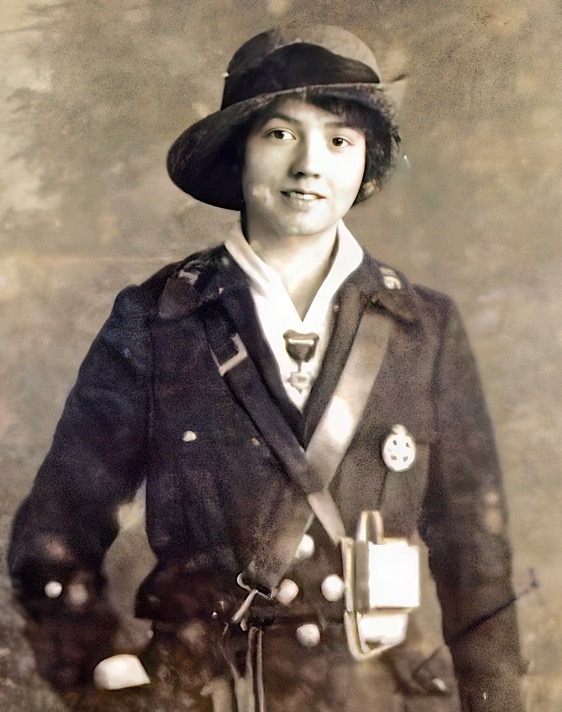
An enlargement of the above photograph showing details of her uniform. Her left-hand collar bears an employee number, and her right system initials, 'W C T', though only the last two letters can be seen. Her straw bonnet bears a ribbon hat band, including what is possibly a rosette; it bears no cap badge.